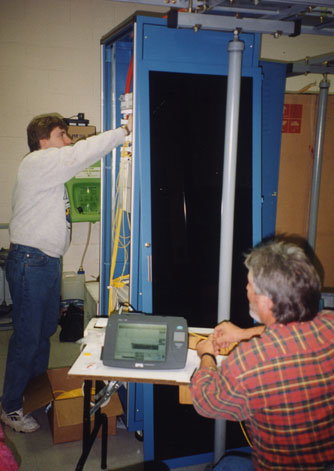Fiber Optic Testing, Lesson 7: Fiber Characterization For Long Haul and High Speed Networks
When you finish this lesson, go here for directions to take the Fiber U Certificate of Completion Exam

Objectives: From this self-study lesson you should learn:
- Which networks may require fiber characterization
-
What are Chromatic Dispersion (CD) and Polarization Mode
Dispersion (PMD)
-
How CD and PMD affect high speed long distance
transmission
-
What is Spectral Attenuation (SA)
-
How SA affects wavelength-division multiplexing
-
How one tests CD, PMD and SA
Introduction
One
of the big advantages of fiber optics is its capability
for long distance high-speed communications. Singlemode
fiber attenuation at long wavelengths (~1550 nm) is
extremely low. Fibers can be fusion spliced with virtually
no loss. High-powered lasers, sophisticated transmission
protocols and fiber amplifier regenerators mean long
distances are easily obtained. Dense wavelength division
multiplexing (DWDM) allows up to 128 channels of signals
on a single fiber.
However, for high-speed networks operating over very long
distances, new factors limiting fiber performance become
important. Chromatic dispersion, the dispersion caused by
light of different wavelengths, and polarization mode
dispersion, caused by the polarization of the light in the
fiber, become factors limiting the bandwidth capacity of
fiber links. Pulse broadening due to chromatic dispersion
and the variation of fiber attenuation with wavelength can
become issues with DWDM.
All these factors need testing on long distance networks
to ensure proper link performance. Tests are performed on
new installations to ensure the fiber being installed is
capable of future upgrades. Older cable plants are tested
to evaluate fibers for upgrades of legacy communications
systems at slower speeds.
A suite of tests for these factors has been developed to
test fibers for long distance high-speed networks. These
tests are normally called “fiber characterization,” but
technically they are “fiber optic cable plant
characterization” since it must include the complete
end-to-end cable plant. That is what this course will cover.
The course leads you to read online or printed
materials (with an emphasis on the online using the FOA Guide), watch
FOA YouTube Videos, complete some activities and take the quizzes. Each
lesson plan will be self-contained. Lesson plans open in new pages so
the course overview page stays open to lead you to the next lesson or
you may use the link at the bottom of the page.
Student Assignment
Read the references, watch the videos and take the quizzes (Test Your Knowledge)
Videos
FOA YouTube Videos,
FOA Lecture 20: Other Fiber Optic Tests (This video covers reflectance, bandwidth, PMD and CD for long haul SM systems and spectral attenuation for WDM systems.)
FOA Lecture 28, Fiber Characterization (Testing long distance high speed networks)
Online FOA Guide
FOA Reference Guide to Fiber Optics
Testing long haul networks (CD, PMD, Spectral Attenuation) (Note links to other relevant pages in the FOA Guide.)
Reference Textbook
FOA Reference Guide to Fiber Optic Testing, Chapter 10
Test Your Knowledge
Online Quiz
FOA Certification
If you have a CFOT and appropriate experience, this course will prepare you for the FOA CFOS/T specialist certification.
You should get your Certificate of Completion for the Fiber Optic
Testing course below before applying to FOA for the certification.
Note: If you are interested in obtaining the FOA CFOS/FC Fiber Characterization certification, you can take the Fiber U Certificate of Completion for Fiber Certification after completing this lesson of the course.
Finished!

Get a "Fiber U Certificate of Completion" When You Complete The Course
After
you complete the Fiber U Fiber Optic Testing online self-study course,
you can now take an online exam and, when you pass the exam, get a
"Certificate of Completion" for this course. You should complete all
lessons including taking the quiz ("Test Your Comprehension") at the end
of every lesson. When you think you are prepared, you can take an
online exam for a nominal fee ($20) which will give you a "Certificate of Completion" for this course.
If
you are working on FOA certification, print out (PDF) your completed
case studies from Lesson 8 and save along with your Fiber U Certificate
of Completion for your application for certification.
When you are ready, go here to take the Fiber U Fiber Optic Testing Certificate of Completion Exam
Please
note: receiving this Fiber U Certificate of Completion does not include
FOA certification or membership but it does become documentation of
your knowledge of fiber optics and should be part of your portfolio of
documented knowledge, other training and work experience that can
qualify you to apply for FOA direct CFOT certification through the FOA
"Work to Cert" program.
Read more about the Fiber U Certificate of Completion program including detail directions on taking the exam.
For more information on the FOA and its certification programs, go to the FOA page on certification.
For information on the FOA "Work
to Cert" direct certification program for those with industry
experience, go here.
|

